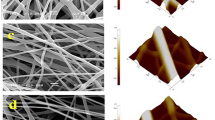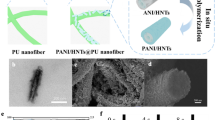Abstract
In this study, the effect of crosslinking conditions was investigated to obtain insoluble poly(ethylene oxide) (PEO) nanofiber mats having an ultraviolet (UV) initiating and crosslinking agent, pentaerythritol triacrylate (PETA), with various ratios in the presence or absence of UV irradiation at 366 nm. At first, PEO nanofibers were electrospun from 400,000 and 600,000 g/mole molecular weights of PEO and they were compared in terms of diameter and fiber morphology. Whereas applied voltage in the range of 10–25 kV had no significant effect on the fiber morphology, fiber diameters varied by voltage. An increase in the flow rate from 0.25 to 1.00 mL h−1 had an effect in favor of fabricating thicker fibers. The effect of distance to collector on the diameter and morphology was not distinctive. Fibers having irregular morphology and beads appeared with increasing the polymer concentration from 4 to 8 % w/v. Prior crosslinking, electrospinning process at selected conditions was applied to the PEO (600,000) including PETA and PEO-PETA nanofibers were obtained. Besides PETA concentration and UV application, drying conditions before UV irradiation were also found effective to obtain stable fibers in aqueous media. PEO nanofibers electrospun in the presence of 10 % PETA (w/w), dried for 8 days at 37 °C in an air atmosphere and then, irradiated with UV for 50 min were found most stable in aqueous media. However, crosslinking was also achieved in the absence of UV.

ᅟ








Similar content being viewed by others
References
Ma L, Deng L, Chen J (2014) Applications of poly(ethylene oxide) in controlled release tablet systems: a review. Drug Dev Ind Pharm 40:845–851
Shah KR, Chaudhary SA, Mehta TA (2014) Polyox (polyethylene oxide) multifunctional polymer in novel drug delivery system. Int J Pharm Sci Drug Res 6:95–101
Nien Y-H, Shih C-Y, Yang C-Y, Lu C-J, Ye Q-X (2013) Preparation and characterization of electrospun polycaprolactone/polyethylene oxide membranes. J Polym Res 20:166–171
Kunteppa H, Parveen A, Kumar HGH, Roy AS (2013) AC conductivity and battery application of polyethylene oxide/PANI/sodium chlorate composites. Adv Mater Lett 4:856–861
Nayak R, Padhye R, Kyratzis IL, Truong YB, Arnold L (2012) Recent advances in nanofibre fabrication techniques. Text Res J 82:129–147
Arslan A, Şimşek M, Aldemir SD, Kazaroğlu NM, Gümüşderelioğlu M (2014) Honey-based PET or PET/chitosan fibrous wound dressings: effect of honey on electrospinning process. J Biomater Sci Polym Ed 25:999–1012
Zong X, Kim K, Fang D, Ran S, Hsiao BS, Chu B (2002) Structure and process relationship of electrospun bioabsorbable nanofiber membranes. Polymer 43:4403–4412
Zeng J, Xu X, Chen X, Liang Q, Bian X, Yang L, Jing X (2003) Biodegradable electrospun fibers for drug delivery. J Control Release 92:227–231
Hekmati AH, Rashidi A, Ghazisaeidi R, Drean J-Y (2013) Effect of needle length, electrospinning distance, and solution concentration on morphological properties of polyamide-6 electrospun nanowebs. Text Res J 83:1452–1466
Chowdhury M, Stylios GK (2012) Analysis of the effect of experimental parameters on the morphology of electrospun polyethylene oxide nanofibres and on their thermal properties. J Text Inst 103:124–138
Deitzel JM, Kleinmeyer J, Harris D, Tan NCB (2001) The effect of processing variables on the morphology of electrospun nanofibers and textiles. Polymer 42:261–272
Doshi J, Reneker DH (1995) Electrospinning process and applications of electrospun fibers. J Electrostat 35:151–160
Fong H, Chun I, Reneker DH (1999) Beaded nanofibers formed during electrospinning. Polymer 40:4585–4592
Son WK, Youk JH, Lee TS, Park WH (2004) The effects of solution properties and polyelectrolyte on electrospinning of ultrafine poly (ethylene oxide) fibers. Polymer 45:2959–2966
Theron SA, Zussman E, Yarin AL (2004) Experimental investigation of the governing parameters in the electrospinning of polymer solutions. Polymer 45:2017–2030
Savaş H, Güven O (2001) Investigation of active substance release from poly (ethylene oxide) hydrogels. Int J Pharm 224:151–158
Merrill EW, Dennison KA, Sung C (1993) Partitioning and diffusion of solutes in hydrogels of poly(ethylene oxide). Biomaterials 14:1117–1126
Doycheva M, Petrova E, Stamenova R, Tsvetanov C, Riess G (2004) UV-induced cross-linking of poly (ethylene oxide) in aqueous solution. Macromol Mater Eng 289:676–680
Doytcheva M, Dotcheva D, Stamenova R, Tsvetanov C (2001) UV-initiated crosslinking of poly(ethylene oxide) with pentaerythritol triacrylate in solid state. Macromol Mater Eng 286:30–33
Doytcheva M, Dotcheva D, Stamenova R, Orahovats A, Tsvetanov C, Leder J (1997) Ultraviolet-induced crosslinking of solid poly(ethylene oxide). J Appl Polym Sci 64:2299–2307
Zhou C, Wang Q, Wu Q (2012) UV-initiated crosslinking of electrospun poly(ethylene oxide) nanofibers with pentaerythritol triacrylate: effect of irradiation time and incorporated cellulose nanocrystals. Carbohydr Polym 87:1779–1786
Doytcheva M, Stamenova R, Zvetkov V, Tsvetanov CB (1998) U.V. irradiation-induced crosslinking of solid poly(ethylene oxide) modified with tetraalkyl ammonium salt. Polymer 39:6715–6721
Reneker DH, Chun I (1996) Nanometre diameter fibres of polymer, produced by electrospinning. Nanotechnology 7:216–233
Zhou C, Chu R, Wu R, Wu Q (2011) Electrospun polyethylene oxide/cellulose nanocrystal composite nanofibrous mats with homogeneous and heterogeneous microstructures. Biomacromolecules 12:2617–2625
Author information
Authors and Affiliations
Corresponding author
Rights and permissions
About this article
Cite this article
Şimşek, M., Çakmak, S. & Gümüşderelioğlu, M. Insoluble poly(ethylene oxide) nanofibrous coating materials: effects of crosslinking conditions on the matrix stability. J Polym Res 23, 236 (2016). https://doi.org/10.1007/s10965-016-1127-x
Received:
Accepted:
Published:
DOI: https://doi.org/10.1007/s10965-016-1127-x




